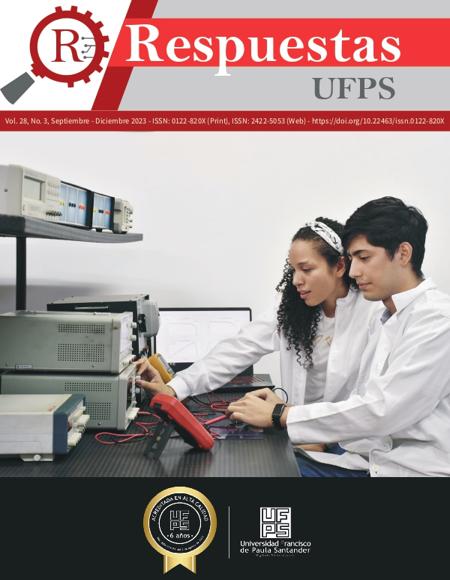Social distancing controlled by video surveillance using open source
Distanciamiento social controlado mediante video vigilancia usando código abierto
Main Article Content
Social distancing has been one of the most used practices to deal with the excessive outbreak of COVID-19 but it has also been little respected by the community. This article proposes video surveillance with computer vision techniques to detect the distancing of people in a controlled environment. The proposed methodology consists of a system adaptable to different video surveillance systems by means of a semi-automatic calibration for the distance that each pixel represents, the algorithm developed in Python obtained an accuracy of 88.4% in the calculation of distances when implemented in a camera from the University of Magdalena.
Downloads
Article Details
J. Bedford et al., “COVID-19: towards controlling of a pandemic,” Lancet Lond. Engl., vol. 395, no. 10229, pp. 1015–1018, Mar. 2020, doi: 10.1016/S0140-6736(20)30673-5.
C. T. Nguyen et al., “Enabling and Emerging Technologies for Social Distancing: A Comprehensive Survey and Open Problems,” IEEE Access, vol. 8, pp. 153479–153507, 2020, doi: 10.1109/ACCESS.2020.3018140.
J. Y. Noh, H. Seong, J. G. Yoon, J. Y. Song, H. J. Cheong, and W. J. Kim, “Social Distancing against COVID-19: Implication for the Control of Influenza,” J. Korean Med. Sci., vol. 35, no. 19, Mar. 2020, doi: 10.3346/jkms.2020.35.e182.
S. Kissler, C. Tedijanto, M. Lipsitch, and Y. H. Grad, “Social distancing strategies for curbing the COVID-19 epidemic.” medRxiv, p. 2020.03.22.20041079, Mar. 24, 2020. doi: 10.1101/2020.03.22.20041079.
N. S. Punn, S. K. Sonbhadra, S. Agarwal, and G. Rai, “Monitoring COVID-19 social distancing with person detection and tracking via fine-tuned YOLO v3 and Deepsort techniques.” arXiv, Apr. 27, 2021. Accessed: Mar. 06, 2023. [Online]. Available: http://arxiv.org/abs/2005.01385
M. Gupta, M. Abdelsalam, and S. Mittal, “Enabling and Enforcing Social Distancing Measures using Smart City and ITS Infrastructures: A COVID-19 Use Case.” arXiv, Apr. 13, 2020. doi: 10.48550/arXiv.2004.09246.
C. E. para A. L. y el Caribe, Las oportunidades de la digitalización en América Latina frente al COVID-19. Comisión Económica para América Latina y el Caribe, 2020. Accessed: Mar. 06, 2023. [Online]. Available: https://www.cepal.org/es/publicaciones/45360-oportunidades-la-digitalizacion-america-latina-frente-al-covid-19
J. R. Márquez V, “Teleconsulta en la pandemia por Coronavirus: desafíos para la telemedicina pos-COVID-19,” Rev. Colomb. Gastroenterol., vol. 35, no. 1, pp. 5–16, May 2020.
R. M. Viner et al., “School closure and management practices during coronavirus outbreaks including COVID-19: a rapid systematic review,” Lancet Child Adolesc. Health, vol. 4, no. 5, pp. 397–404, May 2020, doi: 10.1016/S2352-4642(20)30095-X.
Y. Liang et al., “Progress on the investigation and monitoring of marine phycotoxins in China,” Harmful Algae, vol. 111, p. 102152, Jan. 2022, doi: 10.1016/j.hal.2021.102152.
C. Menni et al., “Real-time tracking of self-reported symptoms to predict potential COVID-19,” Nat. Med., vol. 26, no. 7, Art. no. 7, Jul. 2020, doi: 10.1038/s41591-020-0916-2.
S. A. Chun, A. C.-Y. Li, A. Toliyat, and J. Geller, “Tracking Citizen’s Concerns during COVID-19 Pandemic,” in The 21st Annual International Conference on Digital Government Research, in dg.o ’20. New York, NY, USA: Association for Computing Machinery, Jun. 2020, pp. 322–323. doi: 10.1145/3396956.3397000.
Y. Mejova and K. Kalimeri, “COVID-19 on Facebook Ads: Competing Agendas around a Public Health Crisis,” in Proceedings of the 3rd ACM SIGCAS Conference on Computing and Sustainable Societies, in COMPASS ’20. New York, NY, USA: Association for Computing Machinery, Jul. 2020, pp. 22–31. doi: 10.1145/3378393.3402241.
F. Shahid, S. H. Ony, T. R. Albi, S. Chellappan, A. Vashistha, and A. B. M. A. A. Islam, “Learning from Tweets: Opportunities and Challenges to Inform Policy Making During Dengue Epidemic,” Proc. ACM Hum.-Comput. Interact., vol. 4, no. CSCW1, p. 65:1-65:27, May 2020, doi: 10.1145/3392875.
M. Grambow, J. Hasenburg, and D. Bermbach, “Public Video Surveillance: Using the Fog to Increase Privacy,” in Proceedings of the 5th Workshop on Middleware and Applications for the Internet of Things, in M4IoT’18. New York, NY, USA: Association for Computing Machinery, Dec. 2018, pp. 11–14. doi: 10.1145/3286719.3286722.
M. Rezaei and M. Azarmi, “DeepSOCIAL: Social Distancing Monitoring and Infection Risk Assessment in COVID-19 Pandemic,” Appl. Sci., vol. 10, no. 21, p. 7514, Oct. 2020, doi: 10.3390/app10217514.
I. Ahmed, M. Ahmad, and G. Jeon, “Social distance monitoring framework using deep learning architecture to control infection transmission of COVID-19 pandemic,” Sustain. Cities Soc., vol. 69, p. 102777, Jun. 2021, doi: 10.1016/j.scs.2021.102777.
M. Maity, S. Banerjee, and S. Sinha Chaudhuri, “Faster R-CNN and YOLO based Vehicle detection: A Survey,” 2021 5th Int. Conf. Comput. Methodol. Commun. ICCMC, pp. 1442–1447, Apr. 2021, doi: 10.1109/ICCMC51019.2021.9418274.
J. Redmon and A. Farhadi, “YOLOv3: An Incremental Improvement.” arXiv, Apr. 08, 2018. doi: 10.48550/arXiv.1804.02767.
W. Fang, L. Wang, and P. Ren, “Tinier-YOLO: A Real-Time Object Detection Method for Constrained Environments,” IEEE Access, vol. 8, pp. 1935–1944, 2020, doi: 10.1109/ACCESS.2019.2961959.
F. D. Aferi, T. W. Purboyo, and R. E. Saputra, “Cotton Texture Segmentation Based On Image Texture Analysis Using Gray Level Co-occurrence Matrix (GLCM) And Euclidean Distance,” vol. 13, no. 1, 2018.
M. ÖZBEK, M. SYED, and İ. ÖKSÜZ, “Subjective analysis of social distance monitoring using YOLO v3 architecture andcrowd tracking system,” Turk. J. Electr. Eng. Comput. Sci., vol. 29, no. 2, pp. 1157–1170, Jan. 2021, doi: 10.3906/elk-2008-66.







